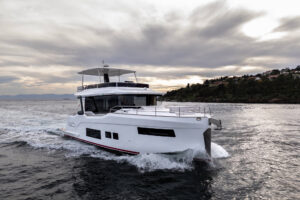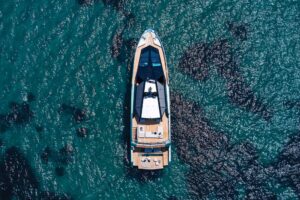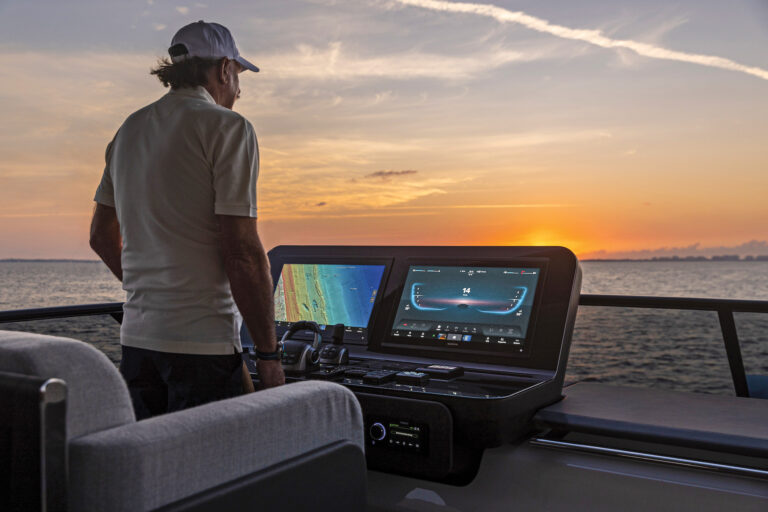Mark Ellis got the bottom right. It’s the perfect platform on which to hang all the other nifty elements of the Bruckmann 56.
Forgive my preference for bottoms, but a yacht’s bottom is her most important element. A great shape below the waterline may be the only difference between a great yacht and a mediocre one.
I spent most of a day aboard hull number one of the Bruckmann 56 and came away thinking she is among the finest midsize motoryachts I’ve experienced. She is seakindly, agile at all speeds, quiet, comfortable and perfect for her purpose-coastal cruising with a crew of four adults or extended cruising with a skipper and mate, intimate or otherwise. For short hops, a stateroom right forward of the galley opposite the utility room/pantry accommodates two guests in over/under berths.
Starting from the bottom, Ellis called on his extensive experience with planing powerboats to develop an optimal configuration for a specific speed range. In this case, Ellis’ client, Arthur Labatt, wanted a cruising speed of about 20 knots and a top speed approaching 30 knots. More important, though, Labatt wanted the yacht to plane at relatively low speeds and to behave well at displacement speed. To him, “behave meant to steer accurately, remain laterally stable and roll minimally in beam seas and wakes.
Ellis drew an interesting variation on the V-hull theme to satisfy the client’s brief. The entry is steep to soften the yacht’s initial encounter with waves. From amidships to the end of the run, the bottom maintains a constant deadrise angle (no twist), as is typical of the Hunt deep-V. The rest of the configuration uniquely combines rocker, wide chine flats and a long skeg to achieve the results the client wanted. Ellis has successfully used variations of this bottom on a number of boats, large and small, outboard and inboard.
Rocker is a longitudinal curvature-a shallow smile when you see the lines in profile. Finding the right amount of rocker may be more black magic than science, but I know it works. Rocker softens the ride in a seaway, and I’ve proved this to myself on a number of motoryachts. The skeg enhances the yacht’s directional stability at all speeds, but it’s especially effective in following seas and wind.
Almost every V-shape planing hull on the water has chine flats, which add lift and provide lateral stability when the boat’s at rest or moving slowly. Ellis gave the Bruckmann 56 substantially wider flats than is common on boats this size, reasoning that the increase in area would improve lift. He was correct. The Bruckmann 56 planes at about 12 knots (1300 rpm) and reaches full plane without squatting. The boat simply rises without the squat of a typical deep-V. What’s more, she will stay on plane if the helmsman drops a few rpm, so the boat doesn’t hunt for a comfortable attitude at transition speeds. On the other hand, when she drops off plane, she gracefully settles to displacement speed, like a prima ballerina coming off pointe.
As I motored through all points of the compass-upwind and down, beam-to and quartering-off the coast of Ft. Lauderdale, I realized the Bruckmann 56 strikes a wonderful compromise. She’s so comfortable and handy at displacement speeds-and so economical, burning about 2 gallons per engine per hour-that she transcends the traditional long-range displacement motoryacht for many yachtsmen. Imagine being able to lope along, sipping fuel, then run up to a 20-knot cruise if, for example, the weather threatened. You’d burn five times the amount of fuel, but you’d get out of the mess.
Test boats are like grandchildren: I get to play with them for a short time and return them when I’ve finished. This arrangement rarely pleases me, and I certainly wasn’t eager to return the 56. Driving this yacht pleased me more than any other aspect of her design. Although Ellis’ naval architecture goes a long way toward making the Bruckmann 56 such a buttoned-down sea boat, the skillful craftsmen at Bruckmann Yachts have taken it the rest of the way. The structure, built of fiberglass over a Core-Cell linear foam core, is enormously stiff. Flat surfaces in the bottom stay flat when the seas beat on them, which contributes to the ride quality. The integrity of this hull, deck and superstructure reduces noise, too-noise of the water working on the hull and noise from the machinery. I wish I could tell you exactly how quiet the 56 was. My sound meter slipped out of the pocket of my windbreaker when I hung out over the side deck to watch the hull go through the water. It now resides somewhere on the floor of the Atlantic. Based on my perception and experience measuring decibels, I rank the 56 as quiet-enough to carry on a conversation in normal tones at the inside helm when the boat is making 20 knots.
Bruckmann Yachts may be an under-appreciated builder south of the border between the United States and Canada, but the yard’s reputation likely will grow as more and more of its yachts find homes in the States. Inside and out, the Bruckmann 56 was expertly done and would compare favorably with the quality we expect from Alden Yachts, Morris Yachts and Hinckley, for example.
A lot of handwork goes into completing the 56, because each boat is custom. Builders who use Core-Cell foam generally construct the boat over male station molds, laying on planks of bead-and-cove Core-Cell the way a builder of traditional wood yachts hangs cedar planks. This is among the most cost-effective ways to build a composite one-off or a small number of yachts in series. This method generally requires a lot of fairing, but careful workmanship and expertly applied paint produce stellar results. I didn’t see any flaws in the topsides during my brief inspection.
Butternut joinerwork fills the interior of this 56. It’s lighter than teak or mahogany, but darker than naturally finished oak or maple. The grain is more open than that of the tropical hardwoods, but the effect is pleasantly unique. On the debit side, butternut is softer than cherry, maple or the tropical hardwoods, so it dents more easily. At least, the satin finish used for the joinerwork won’t announce the presence of a dent with the fanfare often produced by high-gloss varnish.
I liked the arrangement plan quite a lot. The master stateroom is aft over the planing surface of the hull. The motion back there should rarely intrude on the owner’s sleep during overnight passages. It has a private companionway to the cockpit on the port side, allowing the owner and his mate to sip their nightcap under the stars, then quietly descend to a peaceful night’s sleep-all the while remaining invisible to everyone else aboard.
Having the galley in the midst of the action recalls all those gatherings of friends and relatives standing, sitting and leaning in the kitchen. A pair of stools had the place of honor at the breakfast bar on the port side, and when I sat on one of them, I discovered an electric keyboard lurking beneath. So that’s why the Corian counter has a rectangular seam.
One of my favorite spaces-one that reinforces this yacht’s cruising mission-is the utility room/pantry on the starboard side right forward of the helm. It houses a combo washer/dryer, additional refrigeration and dry stowage for food.
Another of my favorite areas, also attesting to the yacht’s ability to cruise safely, is the engineroom. It’s as well lighted and tidy as an operating room. Spacious, too. Straight six-cylinder engines make so much sense in a yacht of this size, because they are narrow. The accessibility to all of the plumbing, wiring and routine service points on the engines may not encourage the owner to inspect the machinery every day, but it won’t discourage him, either.
The Bruckmann 56 is at the top of my short list, with her seakeeping and gentle behavior, her strength and comfort. Her owner is a lucky person.
Contact: Bruckmann Yachts, (800) 254-7618, (905) 855-1117; info@bruckmannyachts.com; www.bruckmannyachts.com.









